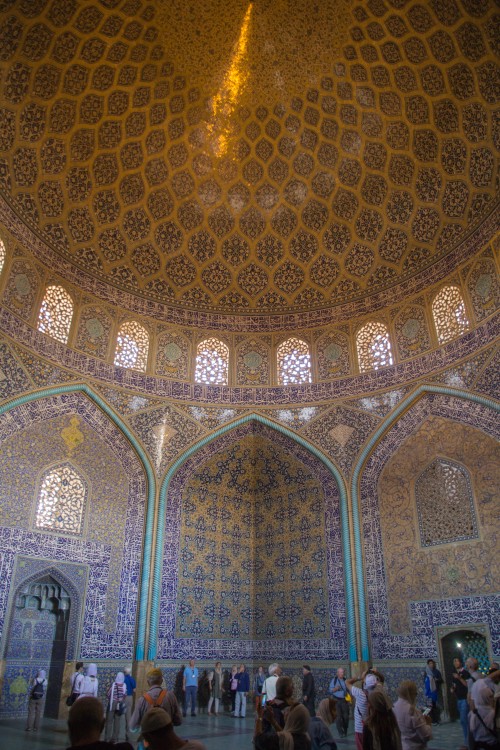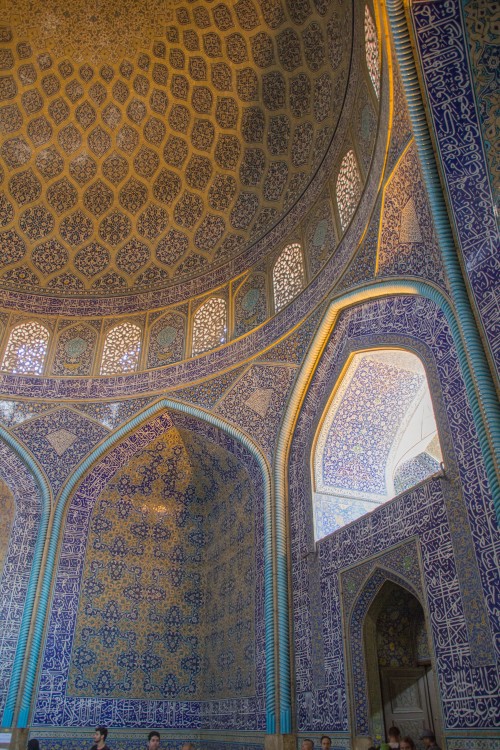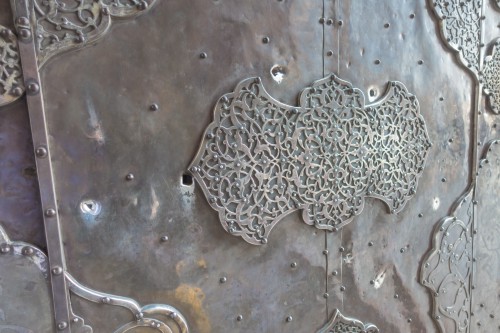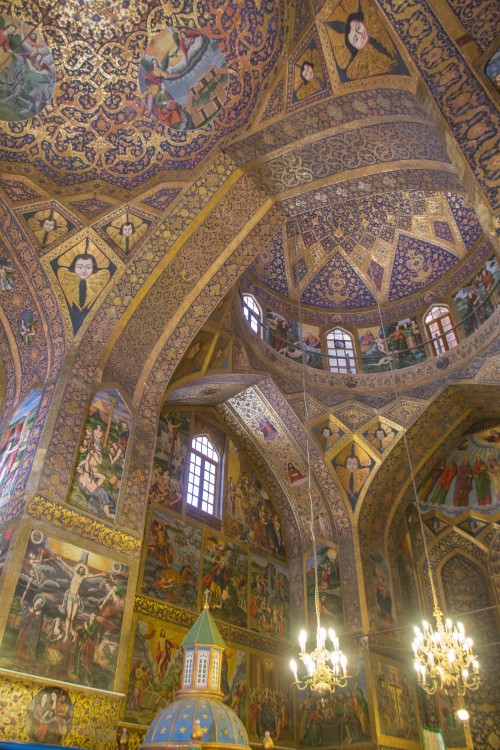Despite getting to sleep at a normal hour, Crystal was still up before 3am. Today Justin at least made it to about 5:30. We tried to get back to sleep, but to no avail. So we checked on the status of our remodel (going on in San Diego), and our Instagram post the night before from Naqsh-e Jahan. The hotel restaurant was one level down from the lobby, and on the way to the stairs we noted that the hotel had a bunch of old computers and devices, probably from the 1970s and 1980s. Most young people wouldn't have a clue what most of the features on the computers even were. Downstairs, breakfast was a zoo, with tons of people, mostly Americans and British, seemingly all part of a large group. Ironically, despite there being so many people, the breakfast setup itself did not have that many choices. They did have an omelette station, but when Justin tried to get one, they just made one without asking what he wanted, and filled it with everything, including lots of mushrooms. So he just ate the egg part on the periphery and left the rest.
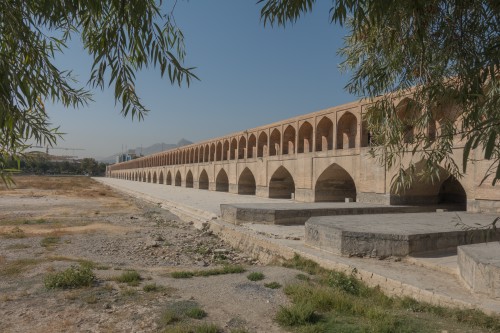 |
 |
We met Amin just before 9. He answered a question we'd had from the day before, which was how warm is the water in the Persian Gulf. He had researched it overnight, and determined that it has a temperature between 75 and 90. Our first stop was the Si-o-se Pol Bridge, also known as the 33 arch bridge. In the fall it's not much of a bridge, as the river was wholly non-existent. Not only has there been more drought because of global warming, but some of the water upstream is now diverted to Yazd to use for drinking water. We will have to come back in April or May one year, as the area would undoubtedly look much different with flowing water instead of a dry riverbed. On the plus side, we were able to go under the bridge and see the design. Interestingly, there was a guy down there sweeping, keeping things clean.
 |
 |
After checking out that bridge, we drove along the north side of the river(bed), which was full of manicured lawns and artwork. There were also trees all along the sides of the roads. It actually reminded both of us of Buenos Aires, half a world away literally and figuratively. The next stop was Khaju bridge. Amin showed us an American buried nearby. Richard Nelson Frye spent his life studying the Persian Empire, and spoke Farsi and Arabic. There were some Iranian hardliners who didn't want him to be buried in Iran since they thought he was a CIA spy, but eventually it was approved. The mausoleum was a smallish building just north of the river. We told Amin that we hoped he'd be the only American buried in Isfahan any time soon. ;-) In the park area near the mausoleum there was a cat stalking some birds that caught our attention, as the cat was gray but striped like a tiger.
 |
 |
The Khaju bridge was built by Shah Abbas II around 1650, using the foundation of a prior bridge. Beyond being a bridge, it was also a building and meeting place, with a pavillion in the center for the Shah and his friends and family. The bridge is about 400 feet long, and almost 25 feet wide. The bridge can also act as a dam, as there are sluice gates that can close as desired to hold water upstream for gardens or other irrigation. Of course, since the river was bone dry today, the sluice gates were pointless.
 |
 |
After leaving Khaju bridge, we drove back to Naqsh-e Jahan Square, as a previous group of photography tourists had told Amin that the inside of the private mosque (Sheikh Lotfollah Mosque) was optimal for pictures at 10am. There was crazy traffic on the east side of square, so eventually we got out and walked last little bit. We made a beeline for Sheikh Lotfollah, and Amin got us tickets. The outside looked nice, and although we had seen it the night before, it was easier to see all the detail in the daylight. The purpose of this particular mosque was to be private for the royal court, as opposed to the general public. It was built in the early 1600s for Shah Abbas I. It was connected to Ali Qapu Palace (across the square from the mosque) by an underground tunnel. When we entered the mosque, there was a curving hallway that eventually came out into the main area, and while nice, didn't get us ready for the main area.
The main room was a huge cavity with an enormous dome on top. The tile work was all sorts of different geometries, shapes, colors, and textures. We walked around for 10 minutes, checking it out from different vantage points. Amin read us a poem from Lord Byron, comparing it favorably to palaces in Versailles, Vienna, Florence and Venice. In hindsight, we should have recorded him reading it, whilst taking video of the room. (As an aside, we would have visited the palaces in Vienna, Florence and Venice if we would have been unable to come to Iran).
The next stop was the main, public mosque. Because the square was arranged North-South-East-West, but Mecca is to the Southwest, the mosque is offset from its entrance. The front door appeared to have bullet holes in it, but who knows. There was a large set-up for a Holy Defense week gathering, as one of the local people was assasinated by IS in Syria, and tonight would be a large memorial ceremony. Accordingly, there was a makeshift scaffolding and tenting that blocked a lot of the views in the mosque area. Amin showed us some yellow tiles that had depictions of animals, which is extremely rare in Islam. The working theory is that they were the result of shared tile-work with an Armenian church in Isfahan around the same time. We walked around for a bit, and it would have been very easy to get lost, as after awhile the walls all look similar (to us, at least), and everything is symmetric. Once we finally got back out to the square, we saw the "Down with USA" sign again. Amin recommended that we not go to the square during the gathering tonight, as it would be extremely crowded - better to be safe than sorry.
We next checked out Ali Qapu Palace, sometimes also known as Holy Door Palace. Some say the palace’s name is actually "Ali’s Gate" because when Shah Abbas I replaced the door of the Imam Ali (Mohammad's son-in-law) shrine in Najaf with a new silver one, he brought back its old door and installed it in Ali Qapu Palace. The interior walls looked like wallpaper, but in fact were put on in layers by hand. There were a fair amount of people, and it was tight quarters, but we made our way up to the top for its viewing area. The viewing area was directly opposite Sheik Lotfollah Mosque, and high enough that you could see past the square to the surrounding neighborhood. The view was good, but lots of scaffolding made it difficult to see everything.
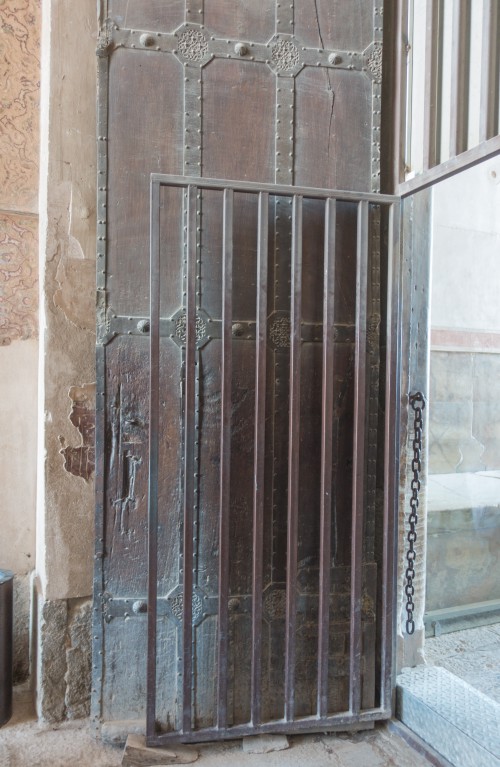 |
 |
 |
We asked Amin if he had any recommendations for places to get handicrafts, because they all looked very similar, and we had no easy way to discern quality. He took us into the bazaar area, behind the square, and showed us a store that had been around for some time. We bought a tea kettle type thing, made out of copper, that looked breakable until we were told it was actually solid copper. We still wrapped it profusely. Lunch was at Bastani Traditional Restaurant, in that same bazaar area just to south of square. Not only did they have Pepsi, the had Mountain Dew as well. The interior of the restaurant was very ornate, with stained glass, regular glass, and arched walls. It must've cost a fortune, and/or taken thousands and thousands of man hours. The soup was great, the food was just okay, but they had this seasonal pomegranate ice cream that was very good.
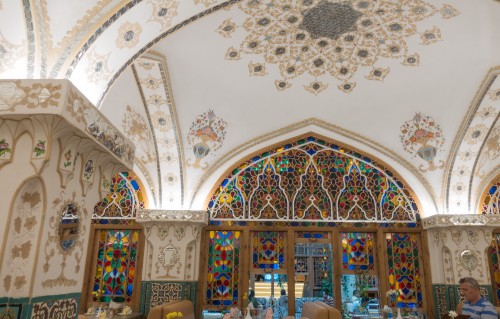 |
 |
We walked out of the square and got picked up about where we were dropped off a few hours earlier. We should've gotten video of all the cars trying to pick up, drop off, flip U-turns, etc. We don't recommend driving that close to the square, as all the roads end, and people are everywhere. The next stop was a very old bridge (Pol-e Sharestan), where you could see the original foundation, and the "new" repairs. We crossed over to the south side of bridge and into the Christian area, originally arraged by Shah Abbas the Great for Armenian people. Shah Abbas gave them a home, and hoped they would help facilitate trade with trade with the Europeans. It worked well for everyone involved. We passed by a "ZFC" Chicken, which not surprisingly looked like a KFC rip-off.
Vank Cathedral was our first stop in the Armenian quarter. It has a large onion dome like a mosque, but with cross on top. There was incredible artwork inside, almost the polar opposite of the artwork inside a mosque, which is mostly just geometric patterns. After looking around the Cathedral, we went to the Armenian museum next door. It had a lot of information about the Armenian genocide. Crystal indicated this was two too many genocide museums we had visited (the other being in Rwanda). One of the highlights of the museum was writing on a human hair. This raised a lot of questions - how did someone get the idea to do this, logistically how did it work, what sort of tooling was used, and once it was done, how did anyone know what was the "special" hair, as it would just look like all other strands of hair? There were no answers, at least not in the museum. There were also lots of other exhibits. One of them were lots of old letters, and the handwriting was incredible - both in terms of style but also how neat it was.
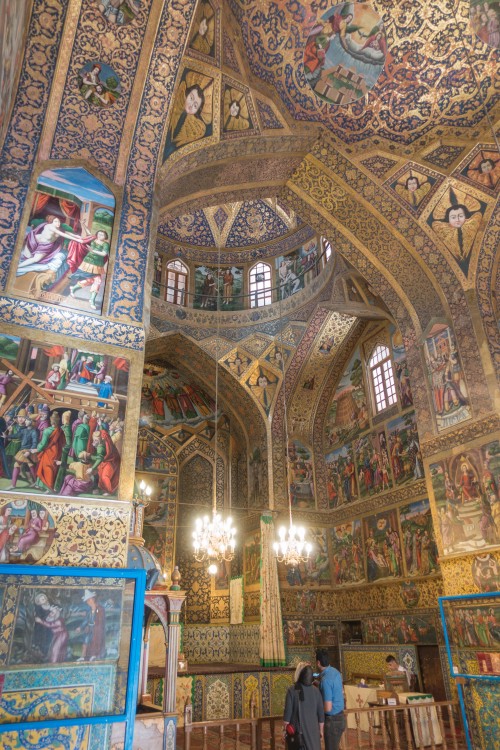 |
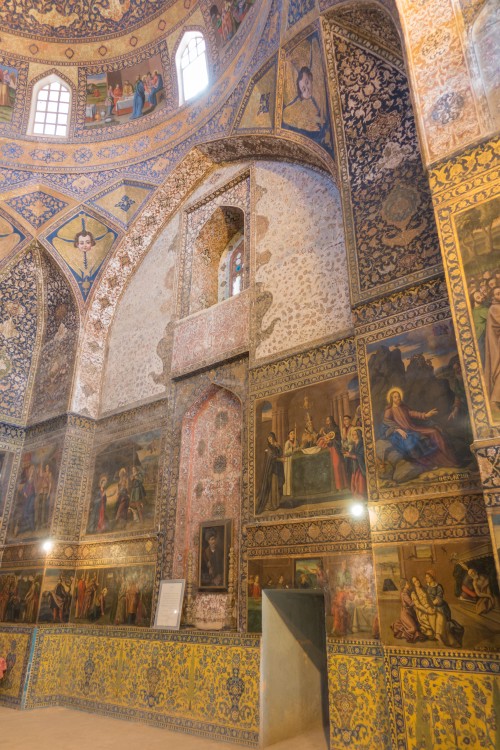 |
We walked around the neighborhood next, and went past a South Park (the cartoon) sign. We have little doubt that Iran will be substantially more "western" in the next 10-15 years, as eventually our television and music culture will wear them down. The next stop was another old church, Bedkhem Church. The artwork resembled that of Vank Cathedral, but on a smaller scale. [In the two photos above, Vank is on the left and Bedkhem is on the right.] But Amin made sure to show us something else, yellow and blue tiles almost the same as in the mosque at Naqsh-e Jahan square, with depictions of animals. If it was truly only coincidence that both buildings had nearly identical tiles, that would be some coincidence. Some of the paintings in the church were very odd, with dragons being stabed and demons with cauldrons of skulls. (Maybe this is why Islam sticks to geometric shapes).
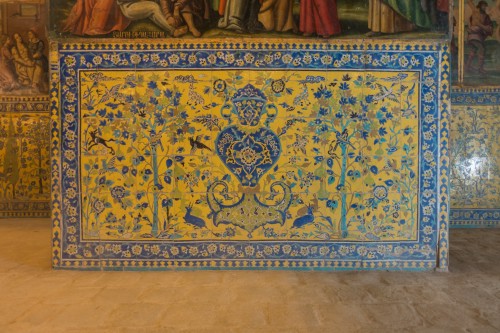 |
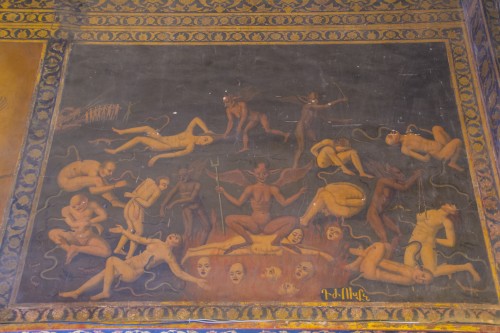 |
From there, we drove back to the hotel. We saw tons of people walking over to the square, almost everyone in black. We decided Amin was correct, and that maybe we'd walk over to the river area instead this evening. We offloaded photos, caught up on the diary, checked the web, but mainly stayed out of sun and heat for a bit. Crystal took a short nap. We kept putting off dinner, as we weren't hungry yet. Eventually we decided we weren't hungry enough for dinner, and just went to sleep around 9.










